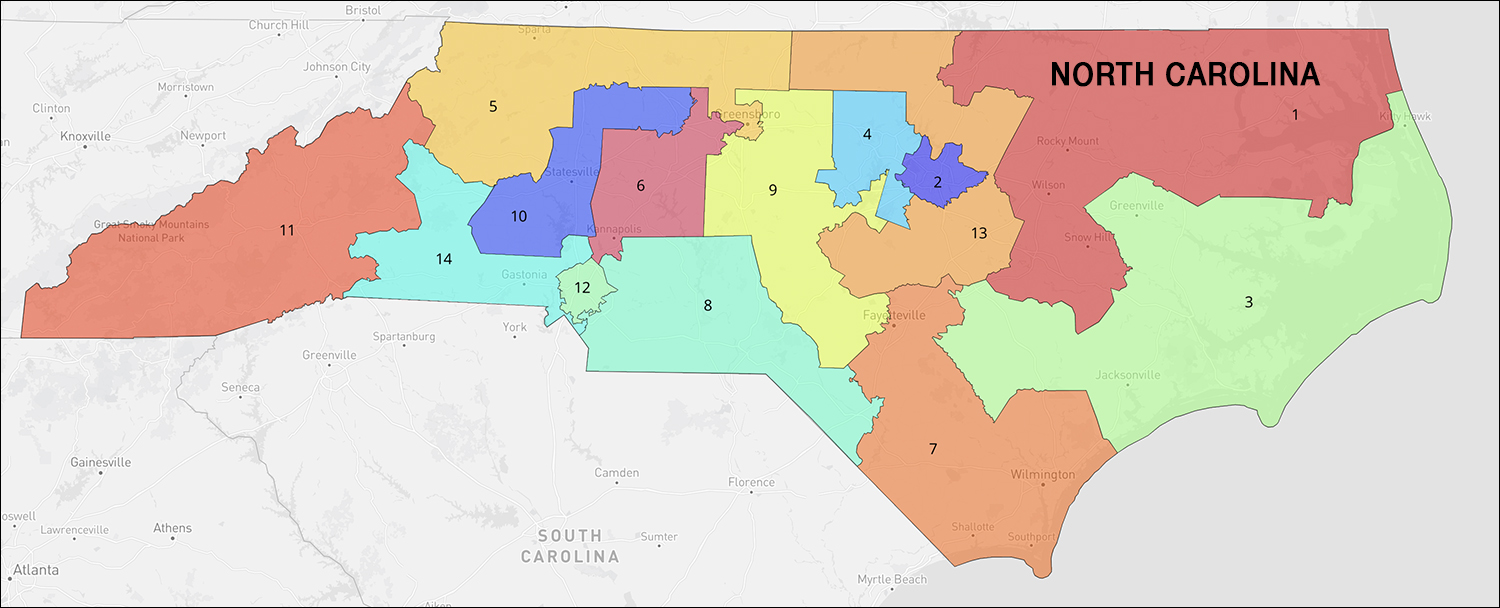
North Carolina redistricting map / Click on image to go to interactive version on Dave’s Redistricting App.
By Jim Ellis — Tuesday, Oct. 7, 2025
Redistricting
The Tar Heel State of North Carolina appears positioned to join the national redistricting wars. The state has been redrawn more than any other since the 2010 census, and it looks like the legislature may again change the congressional district boundaries.
North Carolina has a unique system where the Governor has no veto power over redistricting. Republicans have solid control of both legislative houses, which is all they need to change the map. Before the 2022 election, the legislature and state courts were in a perennial battle over redistricting as it related to the race issue. The Republican legislature would pass a map and the state Supreme Court, with a Democratic majority, would reject it and impose a different draw.
In the 2022 election, the Republicans captured the state Supreme Court majority, thus uniting the legislature and judiciary with regard to redistricting legislation. This led to the General Assembly replacing the court imposed map that yielded each party seven seats and, with judicial approval, enacted the current draw where Republicans control 10 seats and Democrats four.
Turning to the national redistricting wars where many states are redrawing or considering replacing their congressional map, the North Carolina legislative Republicans may make a further adjustment. Doing so would net another GOP seat, thus creating an 11R-3D statewide congressional map.
The target will be the state’s politically marginal eastern 1st District that two-term US Rep. Don Davis (D-Snow Hill) represents. The 1st is one of 13 districts nationally that President Trump carried but the electorate then turned and elected a Democrat to the US House. In NC-1, Trump scored a 51.2 – 48.1 percent victory margin over Kamala Harris. In the same 2024 election, Rep. Davis defeated Republican Laurie Buckhout, 49.5 – 48.7 percent.
North Carolina’s 1st District covers 21 counties and part of one other. The seat hugs the Virginia border from just west of the cities of Rocky Mount and Wilson along Interstate 95 and then moves east all the way to the Atlantic Ocean. It then stretches south and east of Raleigh to achieve population equivalency with the other districts. According to the Dave’s Redistricting App statisticians, the partisan lean here is a fairly tight 50.9D – 47.7R.
Looking at the map from a partisan perspective, which the legislative leaders and the White House certainly are, it would be relatively easy to make the 1st District more Republican, thus making it easier to defeat Rep. Davis.
The 1st shares a border with Rep. Greg Murphy’s (R-Greenville) 3rd District. An interchange of an equal number of Democratic and Republican voters from District 1 to District 3 would endanger Rep. Davis and still create a safe Republican seat for Rep. Murphy while not disrupting the other nine Republican members’ districts. The Dave’s Redistricting App partisan lean for the current CD-3 is 57.2R – 40.7D.
Leaders in many states are discussing redistricting for their next legislative session. The Texas and Missouri maps are complete and will face the perfunctory legal challenges. California Democrats are countering the Texas map with a referendum designed to replace the California Independent Redistricting Commission’ plan enacted in 2021. Polling suggests a close vote for Proposition 50 in the Nov. 4 special statewide election, but the overwhelming Democratic registration numbers and their resource advantage suggest that they can probably win the election.
Both the Texas and California map are drawn with the intent of adding five seats to their party’s congressional delegation, Republicans in Texas and Democrats in California. If the maps perform as designed, the respective five-seat gains will cancel one another. Hence, the importance of other states redrawing their maps for Republicans to strengthen their current US House majority.
If North Carolina redraws, their new Republican seat and the one in Missouri will net the GOP an additional two seats in the House.
The Florida legislature is already planning to redistrict upon their return to regular session in January. Their plan could net the GOP a reported two seats. Indiana Republican legislative leaders, with encouragement from the White House, are potentially considering a redraw that also could net the GOP two seats. Under state law, Ohio must redraw because the current map did not receive three-fifths support in the legislature. The new map could net the GOP a further two seats.
The Utah courts have ruled that their state’s congressional map is illegal because the legislature ignored redistricting criteria that voters adopted in a previous election. A new draw could give the Democrats a net gain of one.
Perhaps the most defining redistricting issue is the Louisiana racial gerrymandering case currently before the US Supreme Court. The justices didn’t rule in June as expected, instead scheduling a new round of oral arguments for Oct. 15. The eventual Louisiana ruling could affect the redistricting situation in several other states and could prove to be the landmark racial gerrymandering ruling that will finally clarify what the states can and can’t do to remain in compliance with the US Constitution and the Voting Rights Act of 1965.
The final redistricting decisions and moves will have a profound impact upon the 2026 US House election cycle. Whichever party ultimately prevails in the better position will have a major advantage toward securing a House majority for the 120th Congress.
